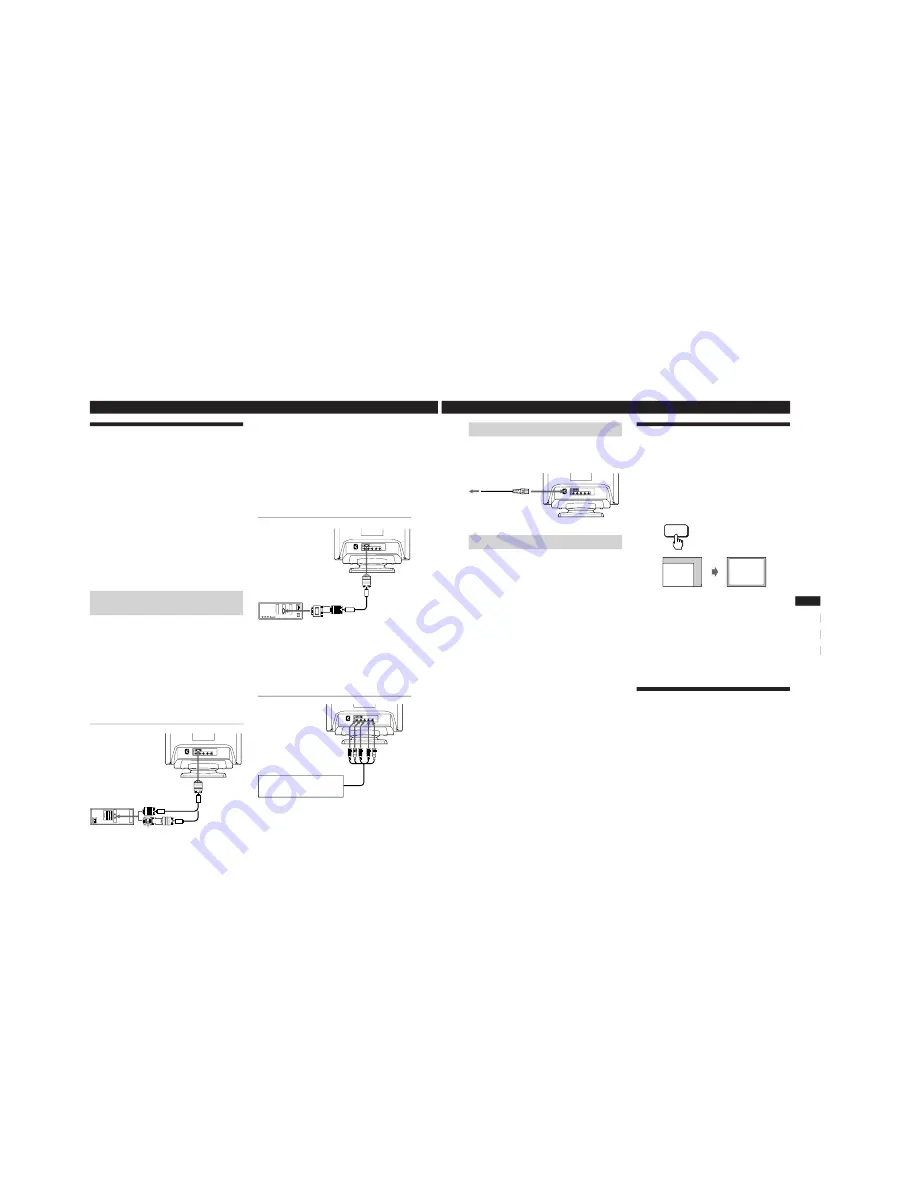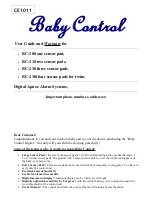
1-2
6
Getting Started
to HD15
to video output
to video output
to VIDEO IN R/G/B
Connect to the computer in
the same way as for the HD15
connector.
If your PC system is not compatible with DDC2AB
and DDC2B+
This monitor uses the No. 9 pin in the video signal connector for
DDC2AB and DDC2B+ compatibility.
Some PC systems which are not compatible with either DDC2AB or
DDC2B+ may not accept the No. 9 pin. If you are not sure whether
your PC system accepts the No. 9 pin or not, use the HD15 (Female)
- HD15 (Male without the No. 9 pin) adapter (not supplied). Make
sure the male side (without the No. 9 pin) is connected to the
computer.
Connecting to a Macintosh or compatible
computer
About the supplied Macintosh adapter
The supplied Macintosh adapter is compatible with Macintosh LC,
Performa, Quadra and Power Macintosh series computers.
Macintosh II series and some older versions of Power Book models
may need an adapter with micro switches (not supplied).
Connecting to the 5 BNC connectors
To connect the 5 BNC connectors, use the SMF-400 video
signal cable (sold separately). Connect the cables from left to
right in the following order: Red–Green–Blue–HD–VD.
Notes
• Do not short the pins of the video signal cable.
• The DDC standard does not apply to the 5 BNC connectors. If
you use the DDC standard, connect the HD15 connector to the
computer with the supplied video signal cable.
HD15 - HD15 adapter
(not supplied)
∗
Macintosh adapter
(supplied)
IBM PC/AT or
compatible
computer
HD15 video
signal cable
(supplied)
Macintosh or
compatible
computer
HD15 video
signal cable
(supplied)
to SYNC IN HD/VD
to HD15
Setup
Before using this monitor, check that the following items are
included in your carton:
• Monitor (1)
• Power cord (1)
• HD15 video signal cable (1)
• Macintosh adapter (1)
• Windows
®
95 Monitor Information Disk/File (1)
• Warranty card (1)
• Notes on cleaning the screen’s surface (1)
• These operating instructions (1)
This monitor works with any IBM or compatible system
equipped with VGA or greater graphics capability.
Although this monitor works with other platforms running
at horizontal frequencies between 30 and 96 kHz, including
Macintosh and Power Macintosh systems, a cable adapter is
required. Please consult your dealer for advice on which
adapter is suitable for your needs.
Step 1: Connect the monitor to the
computer
With the computer switched off, connect the video signal
cable to the monitor using the supplied HD15 video signal
cable.
• If you are using an IBM PC/AT or compatible computer,
refer to the section below.
• If you are using a Macintosh or compatible computer,
refer to the following section, “Connecting to a Macintosh
or compatible computer.”
• If you want to use the 5 BNC connectors, refer to the
section, “Connecting to the 5 BNC connectors.”
Connecting to an IBM PC/AT or compatible
computer
*
The HD15 - HD15 adapter may be needed for some models.
7
Getting Started
Getting Started
F
EN
ES
C
to a power outlet
Power cord (supplied)
Automatically Adjusting the Size
and Centering of the Picture
By pressing the auto sizing and centering (ASC) button, the
size and centering of the picture are automatically adjusted
to fit the screen.
1
Turn on the monitor and computer.
2
Press the ASC button.
The picture is adjusted to fit the center of the screen.
Notes
• This function is intended for use with a computer running
Windows or similar graphic user interface software that
provides a full-screen picture. It may not work properly if the
background color is dark or if the input picture does not fill the
screen to the edges (such as an MS-DOS prompt).
• The screen may go blank for a few seconds while performing the
auto-sizing function. This is not a malfunction.
• Although the signals for picture aspect ratio 5:4 (resolution: 1280
×
1024) do not fill the screen to the edges, the picture is
accurately displayed.
Selecting the On-screen Display
Language
If you need to change the OSD language, see “Using the
LANG (Language) On-screen Display” on page 17.
The default setting is English.
Step 2: Connect the power cord
With the monitor switched off, connect one end of the
power cord to the monitor and the other end to a power
outlet.
Step 3: Turn on the monitor and computer
The installation of your monitor is complete.
Note
If “OUT OF SCAN RANGE” or “NO INPUT SIGNAL” appears on
the screen, see “Warning Messages” on page 20.
For customers using Windows
®
95
Install the new model information from the “Windows 95 Monitor
Information Disk” into your PC. (To install the file, refer to the
attached “About the Windows 95 Monitor Information Disk/File.”)
This monitor complies with the “VESA
DDC” Plug&Play standard.
If your PC/graphics board complies with DDC, select “Plug and
Play Monitor (VESA DDC)” as “Monitor type” from “Control
Panel” in Windows 95. Some PCs/graphics boards do not comply
with DDC. Even if your computer complies with DDC, it may have
some problems connecting with this monitor. In this case, select this
monitor‘s model name (CPD-520GS) as “Monitor type” in Windows
95.
For customers using Windows NT4.0
Monitor setup in Windows NT4.0 is different from Windows 95 and
does not involve the selection of monitor type. Refer to the
Windows NT4.0 instruction manual for further details on adjusting
the resolution, refresh rate, and number of colors.
ASC
to AC IN
Summary of Contents for CPD-520GS - 21" CRT Display
Page 25: ...5 1 5 2 SECTION 5 DIAGRAMS 5 1 BLOCK DIAGRAMS ...
Page 26: ...5 3 5 4 ...
Page 39: ...MEMO ...








































